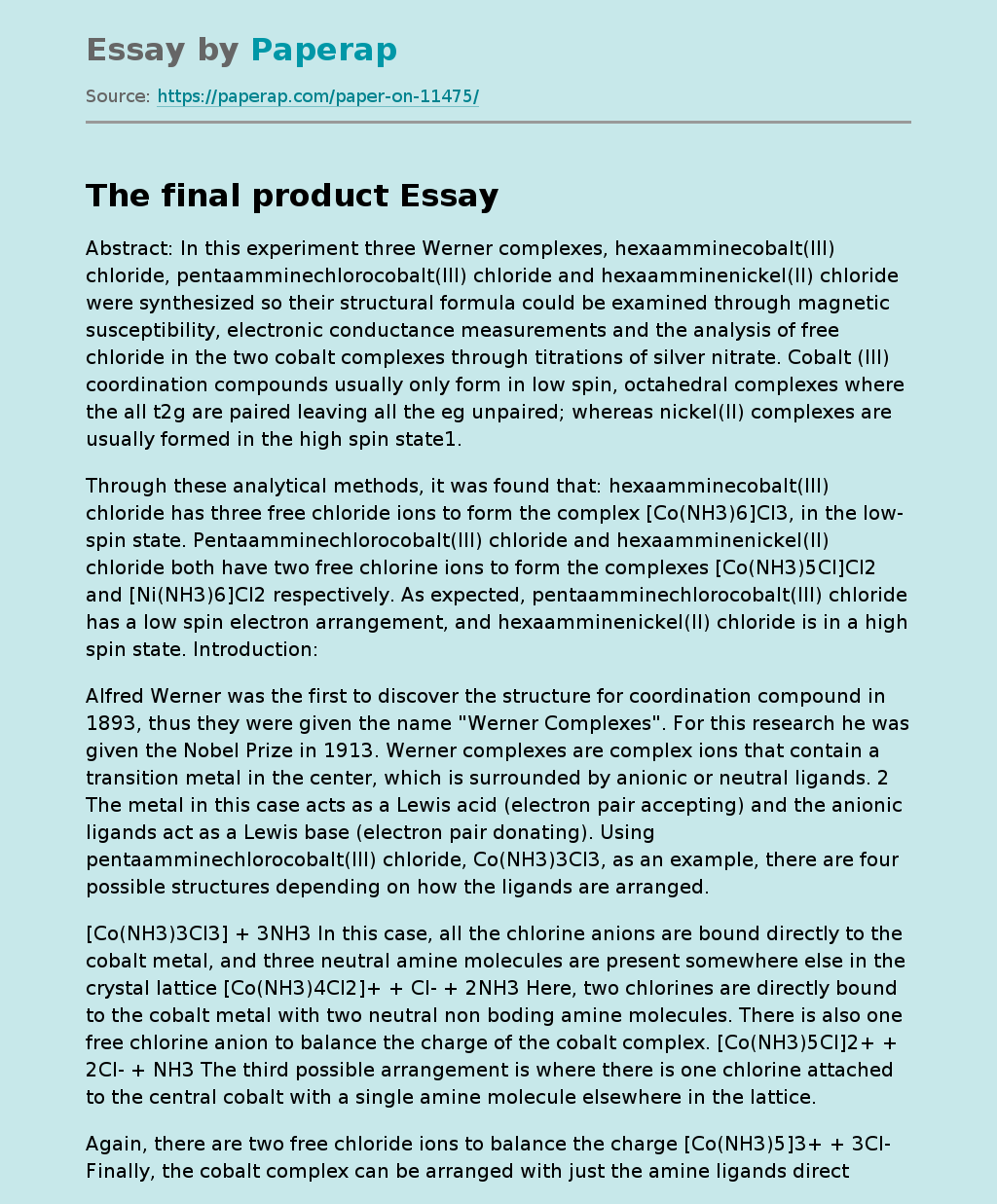Abstract: In this experiment three Werner complexes, hexaamminecobalt(III) chloride, pentaamminechlorocobalt(III) chloride and hexaamminenickel(II) chloride were synthesized so their structural formula could be examined through magnetic susceptibility, electronic conductance measurements and the analysis of free chloride in the two cobalt complexes through titrations of silver nitrate. Cobalt (III) coordination compounds usually only form in low spin, octahedral complexes where the all t2g are paired leaving all the eg unpaired; whereas nickel(II) complexes are usually formed in the high spin state1.
Through these analytical methods, it was found that: hexaamminecobalt(III) chloride has three free chloride ions to form the complex [Co(NH3)6]Cl3, in the low-spin state. Pentaamminechlorocobalt(III) chloride and hexaamminenickel(II) chloride both have two free chlorine ions to form the complexes [Co(NH3)5Cl]Cl2 and [Ni(NH3)6]Cl2 respectively. As expected, pentaamminechlorocobalt(III) chloride has a low spin electron arrangement, and hexaamminenickel(II) chloride is in a high spin state. Introduction:
Alfred Werner was the first to discover the structure for coordination compound in 1893, thus they were given the name “Werner Complexes”.
For this research he was given the Nobel Prize in 1913. Werner complexes are complex ions that contain a transition metal in the center, which is surrounded by anionic or neutral ligands. 2 The metal in this case acts as a Lewis acid (electron pair accepting) and the anionic ligands act as a Lewis base (electron pair donating). Using pentaamminechlorocobalt(III) chloride, Co(NH3)3Cl3, as an example, there are four possible structures depending on how the ligands are arranged.
[Co(NH3)3Cl3] + 3NH3 In this case, all the chlorine anions are bound directly to the cobalt metal, and three neutral amine molecules are present somewhere else in the crystal lattice [Co(NH3)4Cl2]+ + Cl- + 2NH3 Here, two chlorines are directly bound to the cobalt metal with two neutral non boding amine molecules. There is also one free chlorine anion to balance the charge of the cobalt complex. [Co(NH3)5Cl]2+ + 2Cl- + NH3 The third possible arrangement is where there is one chlorine attached to the central cobalt with a single amine molecule elsewhere in the lattice.
Again, there are two free chloride ions to balance the charge [Co(NH3)5]3+ + 3Cl- Finally, the cobalt complex can be arranged with just the amine ligands directly bound to it in a square pyramidal geometry instead of a more stable octahedral geometry seen in the other three complexes. This leaves the three chlorine anions non-bonded, and counterbalancing the 3+ charge from the complex. To find the actual arrangement and geometry of the three complexes, conductance measurements, magnetic susceptibility and free chloride ions through titrations can be measured and analyzed.
Electronic conductance measurements helps determine the amount of chloride ions not attached to the metal. This is possible because when dissolving a salt in water, the molecule separates into cations and anions, each which can conduct electricity. The conductance measured can be compared to a literature reference of how many total ions correspond to the value. With this, logically dividing the charges between the cations and anions present will help determine the overall structure of the molecule. The second technique for determining the amount of ions present in a Werner complex is magnetic susceptibility.
With finding the magnetic susceptibility using a magnetic susceptibility of a compound, one can calculate whether the compound is paramagnetic or diamagnetic. If the mass magnetic susceptibility, ? g, is negative, then the compound is diamagnetic; however, if ? g is positive, then the compound is paramagnetic. The apparatus used for this experiment is a Evans/Johnson Mathey Magnetic Susceptibility Balance. The last technique used was titrating a sample with silver nitrate. Since the three samples contain chloride ions, titrating it with silver nitrate would precipitate silver chloride, which is very insoluble.
Based on the volume of silver nitrate used to reach the end point, one can calculate the amount of silver chloride precipitated. The amount of silver chloride precipitated is also the amount of free chloride ions in the mixture. Comparing the ratio of moles of silver nitrate used to the moles of analyte in the mixture will show the amount of non-bonding chlorine present. Procedure and observations: Synthesis of hexaamminecobalt(III) chloride:
The synthesis was started by adding cobalt(II) chloride hexahydrate(4. 690g) and ammonium chloride (2.946g) to water(5mL) which formed a purple solution from the original red/pink powder. This solution was heated up and turned dark blue once it was all dissolved. Activating charcoal was then added as a catalyst – the solution was then black with a slight blue tint. Afterwards, concentrated ammonia (9. 8mL) was added to the mixture. This created a very dark red solution, but upon setting, the color eventually faded to yellow with a bit of red in it. With this, the solution was then cooled in a tab water bath and hydrogen peroxide (10. 0mL, 6%) was added and heated to 65 degrees Celsius for 17 minutes.
To crystallize, the solution was then places in another tap water bath, proceeded by an ice water bath. The brown crystals were then filtered by vacuum filtration and transferred to another beaker containing concentrated hydrochloric acid (2. 1mL) and water (41. 0mL). After all the crystals were dissolved, they were filtered by gravity filtration and washed with water (1. 7mL). The red/gold filtrate was collected, and another portion of concentrated hydrochloric acid(5. 2mL) was added. The filtrate was then cooled on ice to crystallize once more. Upon cooling, the solution turned bright orange.
The sides of the erlenmeyer flask had to be scratched vigorously to help induce the production of crystals. Finally, the crystals were filtered once more by vacuum filtration, and dried between two pieces of large filter paper. The final product were bright orange crystals(0. 123g) at a 2. 36% yield. Synthesis of pentaamminechlorocobalt(III) chloride: To start the synthesis, solid ammonium chloride (7. 560g) was added to a beaker containing ammonia (44. 6mL, 14M). While stirring, finely powdered cobalt(II) chloride hexahydrate (7. 465g) was slowly added.
The final product. (2017, Dec 27). Retrieved from https://paperap.com/paper-on-11475/

